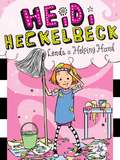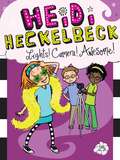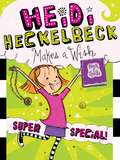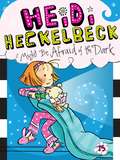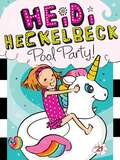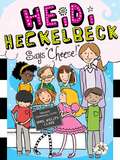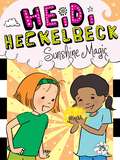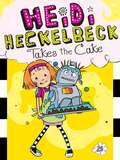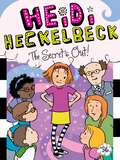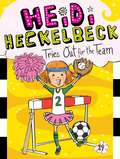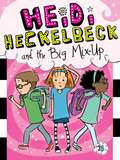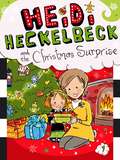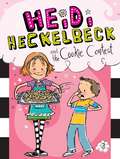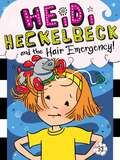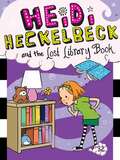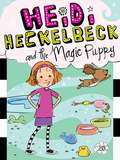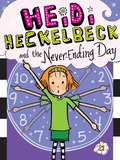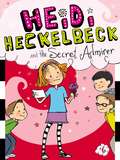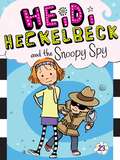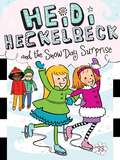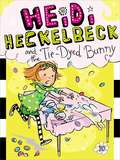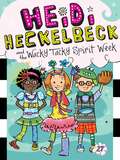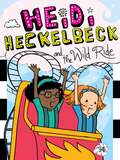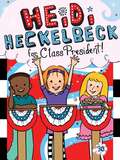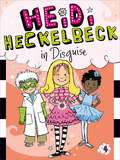- Table View
- List View
Heidi Heckelbeck Lends a Helping Hand (Heidi Heckelbeck #26)
by Wanda CovenHeidi lends a helping hand in the twenty-sixth Heidi Heckelbeck adventure!One day, when Heidi’s teacher, Mrs. Welli, teaches a lesson on the importance of helping and giving back to the community, she and her friends decide that it’s time to volunteer! With easy-to-read language and illustrations on almost every page, the Heidi Heckelbeck chapter books are perfect for beginning readers. <P><P><i>Advisory: This book offers only partial accessibility. We have kept it in the collection because it is useful for some of our members. Benetech is actively working on projects to improve accessibility issues such as these in the future.</i>
Heidi Heckelbeck Lights! Camera! Awesome! (Heidi Heckelbeck #25)
by Wanda Coven Priscilla BurrisHeidi stars in a video project for school in the twenty-fifth Heidi Heckelbeck adventure!Brewster Elementary School is going to have its very own weekly news program, and there will be a talent contest to find the perfect student host. Melanie Maplethorpe thinks she is destined to be the star of the show, but not if Heidi can help it. With a little magic from her Book of Spells, Heidi instantly becomes famous at her school, but is fifteen minutes of fame enough to make her the right person for the job? With easy-to-read language and illustrations on almost every page, the Heidi Heckelbeck chapter books are perfect for beginning readers.
Heidi Heckelbeck Makes a Wish: Super Special! (Heidi Heckelbeck #17)
by Wanda Coven Priscilla BurrisIn this first Heidi Heckelbeck super special, Heidi makes a drastic wish—but once it comes true, she finds it may not be the answer to all of her problems. When another magical spell goes wrong, Heidi makes a powerful wish: “Sometimes I wish I wasn’t a witch!” But when Heidi’s wish comes true, she has to figure out a way to get her magic back, while also helping her friends solve a few problems of their own. Only this time, she’ll have to help without casting a spell. Will Heidi realize just how special her magic is?
Heidi Heckelbeck Might Be Afraid of the Dark (Heidi Heckelbeck #15)
by Wanda Coven Priscilla BurrisHeidi Heckelbeck is a little witch with a big problem: she might...just maybe...be a little afraid of the dark!Heidi Heckelbeck is going to her first sleepover! She's packed her special polka dot pajamas and can't wait to curl up in her brand-new sleeping bag. Until she realizes that she'll never fall asleep without the lights on! Because Heidi has another teeny-tiny secret: she's afraid of the dark! What will all the other girls say? Melanie will tease her for sure. Can she use her book of spells to conjure up some light? With easy-to-read language and illustrations on almost every page, the Heidi Heckelbeck chapter books are perfect for beginning readers.
Heidi Heckelbeck Pool Party! (Heidi Heckelbeck #29)
by Wanda CovenIn this twenty-ninth Heidi Heckelbeck adventure, Heidi and her friends have a pool party!When Heidi&’s swim team, the Little Mermaids, want to raise money for new swim caps and goggles, Heidi helps with the perfect idea: They should throw a pool party! The temperature in Brewster has been hot, hot, hot, and all the kids in town are looking for a way to cool down. With the help of her team, friends, and a little magic, Heidi brings her pool party idea to life. With easy-to-read language and illustrations on almost every page, the Heidi Heckelbeck chapter books are perfect for beginning readers.
Heidi Heckelbeck Says "Cheese!" (Heidi Heckelbeck #14)
by Wanda Coven Priscilla BurrisHeidi Heckelbeck is a little witch with a big problem: she's missing her front tooth! Can she fill the gap with some magic in time for class picture day?Heidi Heckelbeck has a loose front tooth, and class picture day is just around the corner. Despite being as careful as can be, Heidi loses the tooth--and ends up with a big hole in her smile! Can she use her Book of Spells to create a new tooth? Or will she have to learn to love her new look?With easy-to-read language and illustrations on almost every page, the Heidi Heckelbeck chapter books are perfect for beginning readers.
Heidi Heckelbeck Sunshine Magic (Heidi Heckelbeck #35)
by Wanda CovenHeidi&’s family vacation has sunshine and magic in the air in this thirty-fifth Heidi Heckelbeck adventure!Heidi and her family are taking a trip to the Castle Spell Cove, a special place where Heidi&’s mom and Aunt Trudy used to visit when they were kids. Once there, Heidi makes friends with an unusual girl named Sunny who has a magical secret of her own that will change Heidi&’s life forever. With easy-to-read language and illustrations on almost every page, the Heidi Heckelbeck chapter books are perfect for beginning readers.
Heidi Heckelbeck Takes the Cake (Heidi Heckelbeck #28)
by Wanda CovenHeidi forgets her best friend&’s birthday in the twenty-eighth Heidi Heckelbeck adventure!Between reading, homework, school projects, and everyday life, Heidi Heckelbeck is a very busy kid. But when her busy life keeps her from remembering her friend Bruce&’s birthday, Heidi decides to throw a magical make-up party to apologize. Will he forgive her…or will this party be another magical mess? With easy-to-read language and illustrations on almost every page, the Heidi Heckelbeck chapter books are perfect for beginning readers.
Heidi Heckelbeck The Secret's Out! (Heidi Heckelbeck #36)
by Wanda CovenHeidi&’s magical secret may be out of the bag in this thirty-sixth Heidi Heckelbeck adventure!Is the town of Brewster ready to learn the truth about Heidi Heckelbeck? Or would Heidi be better off if her magic disappeared forever? With easy-to-read language and illustrations on almost every page, the Heidi Heckelbeck chapter books are perfect for beginning readers.
Heidi Heckelbeck Tries Out for the Team (Heidi Heckelbeck #19)
by Wanda Coven Priscilla BurrisIn the nineteenth Heidi Heckelbeck adventure, Heidi looks for the perfect sport to play.It’s time to sign up for sports at school and Heidi is excited (and a little nervous) to find the perfect fit. Lucy is great at soccer. Bruce is great at baseball. Heidi, well, the only thing she’s great at is being awful at every sport she plays! Can Heidi shake off her slump with a little magic or will Melanie’s teasing make her throw in the towel for good? With easy-to-read language and illustrations on almost every page, the Heidi Heckelbeck chapter books are perfect for beginning readers.
Heidi Heckelbeck and the Big Mix-Up (Heidi Heckelbeck #18)
by Wanda Coven Priscilla BurrisIn the eighteenth Heidi Heckelbeck adventure, Heidi is stuck between her two best friends who have turned into two worst enemies. And she'll need more than a little magic to bring them back together!Heidi learns that words can hurt when an embarrassing rumor about Lucy spreads at school. What's worse is that Lucy thinks Bruce is behind it--and she's ready to spill some of his secrets for revenge. Stuck between her two best friends, can Heidi find a way to bring everyone back together before the trio splits up forever? With easy-to-read language and illustrations on almost ever page of this extra-long story, the Heidi Heckelbeck chapter books are perfect for beginning readers.
Heidi Heckelbeck and the Christmas Surprise: Heidi Heckelbeck Has A Secret; Casts A Spell; And The Cookie Contest; In Disguise; Gets Glasses; And The Secret Admirer; Is Ready To Dance!; Goes To Camp!; And The Christmas Surprise; And The Tie-dyed Bunny (Heidi Heckelbeck #9)
by Wanda CovenWhen Heidi gets in some Christmastime trouble, it will take more than magic to restore the holiday spirit!Christmas is around the corner, and Heidi is very excited. She loves Christmas decorations, Christmas cookies, and, best of all, Christmas presents! But when she takes her mom’s special charm bracelet without asking—and then loses it—Heidi fears that her mom will be angry with her. And when she finally finds the bracelet, it has been totally crushed by a snowplow. Heidi tries to fix the broken bracelet with a spell, but that only makes things worse! Will Heidi have the courage to come clean and tell her mom the truth—and will there still be room for Christmas cheer? With easy-to-read language and illustrations on almost every page, the Heidi Heckelbeck chapter books are perfect for beginning readers.
Heidi Heckelbeck and the Cookie Contest: Heidi Heckelbeck Has A Secret; Casts A Spell; And The Cookie Contest; In Disguise; Gets Glasses; And The Secret Admirer; Is Ready To Dance!; Goes To Camp!; And The Christmas Surprise; And The Tie-dyed Bunny (Heidi Heckelbeck #3)
by Wanda CovenHeidi Heckelbeck mixes up a magical cookie concoction in a new whimsically witchy adventure that’s perfect for beginning readers. Heidi can’t wait to enter the famous Heckelbeck Chocolate Chunk Cookies in the annual cookie contest at Brewster Elementary. But when Melanie Maplethorpe laughs and says that Heidi’s cookies are “blah,” Heidi decides they could use a little magic. The result of Heidi’s revised recipe is sure to steal the show…but wait—what’s that strange smell? The Heidi Heckelbeck series is perfect for readers who want a “grown-up” format but are not quite ready for lengthy chapter books. With easy-to-read language and illustrations on almost every page, the Heidi Heckelbeck chapter books are perfect for beginning readers.
Heidi Heckelbeck and the Hair Emergency! (Heidi Heckelbeck #31)
by Wanda CovenHeidi has a major hair emergency in this thirty-first Heidi Heckelbeck adventure!What starts as an ordinary Sunday at the Heckelbeck house turns into a hair-raising adventure for the whole family when one of Henry&’s toys gets stuck in Heidi&’s hair! Mom&’s only solution is to cut a chunk of Heidi&’s hair, but when the salon can&’t undo the horrible hairdo, Heidi must use magic to save the day. But will her magical hairdo become a hair don&’t? With easy-to-read language and illustrations on almost every page, the Heidi Heckelbeck chapter books are perfect for beginning readers.
Heidi Heckelbeck and the Lost Library Book (Heidi Heckelbeck #32)
by Wanda CovenHeidi has an overdue adventure when she loses a library book in this thirty-second Heidi Heckelbeck adventure!The Brewster Library has always been a magical place for kids in town. It has a story waiting for everyone. But imagine Heidi&’s surprise when Aunt Trudy lets her in on a well-kept secret: the Brewster Library has a real magic section! When Heidi checks out a title for a special project, she learns that you can&’t always judge a book by its cover. Especially when it&’s a bewitched book that loves to play pranks. With easy-to-read language and illustrations on almost every page, the Heidi Heckelbeck chapter books are perfect for beginning readers.
Heidi Heckelbeck and the Magic Puppy (Heidi Heckelbeck #20)
by Wanda Coven Priscilla BurrisIn the twentieth Heidi Heckelbeck adventure, Heidi gets in some magic puppy trouble!When Heidi stumbles across a lost puppy at the park, she promises to find the cute critter’s family. Along with Bruce and Lucy, Heidi tries her hardest to solve this mystery. They check the local dog park, visit the vet’s office, and even hang up Found Puppy posters, but they can’t find the owners anywhere. So Heidi decides to use just a teensy-weensy pinch of magic that sets off a mega-gigantic case of magic puppy trouble. Maybe this is why witches only have cats for pets? With easy-to-read language and illustrations on almost every page, the Heidi Heckelbeck chapter books are perfect for beginning readers.
Heidi Heckelbeck and the Never-Ending Day (Heidi Heckelbeck #21)
by Wanda Coven Priscilla BurrisHeidi wishes her perfect day would never end in the twenty-first Heidi Heckelbeck adventure!When Heidi wakes up to a bird singing at her window, she has a feeling that this Saturday might be the best day ever. Then, after her favorite breakfast, a shopping trip with friends, and an incredible movie night sleepover, Heidi knows it’s better than the best day. It’s the perfect day! In fact, it’s so good that Heidi sneaks in a little magic to make every day just as awesome. But when she wakes up to relive the same perfect day over and over again…will her best day ever turn into a never-ending disaster? With easy-to-read language and illustrations on almost every page, the Heidi Heckelbeck chapter books are perfect for beginning readers.
Heidi Heckelbeck and the Secret Admirer: Heidi Heckelbeck Gets Glasses; Heidi Heckelbeck And The Secret Admirer; Heidi Heckelbeck Is Ready To Dance!; Heidi Heckelbeck Goes To Camp! (Heidi Heckelbeck #6)
by Wanda Coven Priscilla BurrisSomeone has a crush on Heidi Heckelbeck! Can she figure out who it is--with a little help from her Book of Spells?The Brewster Science Fair is approaching, and Heidi and Stanley are busy working on their project. But when Heidi finds treats in her cubby and her desk, she realizes that she has a secret admirer! Who can it be? Heidi starts to investigate, and she eventually turns to her Book of Spells for help. Will she discover her admirer's true identity? With easy-to-read language and illustrations on almost every page, the Heidi Heckelbeck chapter books are perfect for beginning readers.
Heidi Heckelbeck and the Snoopy Spy (Heidi Heckelbeck #23)
by Wanda CovenIn the twenty-third Heidi Heckelbeck adventure, Heidi discovers a snoopy spy in her house!Heidi&’s little brother, Henry, has turned into a snoopy, little spy and it is driving her crazy! He spies when her friends are over at their house. He spies on the school bus. He even spies on the playground! But when he almost tells one of Heidi&’s secrets to Melanie Maplethorpe, it&’s time to catch a spy! Will Heidi cast the perfect spell to stop her bothersome brother, or will her magic spill the biggest, Heidi secret ever? With easy-to-read language and illustrations on almost every page, the Heidi Heckelbeck chapter books are perfect for beginning readers.
Heidi Heckelbeck and the Snow Day Surprise (Heidi Heckelbeck #33)
by Wanda CovenHeidi and her friends conjure up the perfect snow day surprise in this thirty-third Heidi Heckelbeck adventure!Winter is coming to Brewster. There&’s a crisp, chill feeling in the air and everyone watches the clouds, waiting for snow to finally fall. But after a week of non-stop rain, Heidi Heckelbeck and her friends wonder if it will ever snow again. Dreams of building snowmen and ice skating in the park are quickly washing away, until Heidi uses a little magic to help Mother Nature. Now the town is in for a real snow day surprise! With easy-to-read language and illustrations on almost every page, the Heidi Heckelbeck chapter books are perfect for beginning readers.
Heidi Heckelbeck and the Tie-Dyed Bunny: Heidi Heckelbeck And The Christmas Surprise; Heidi Heckelbeck And The Tie-dyed Bunny; Heidi Heckelbeck Is A Flower Girl; Heidi Heckelbeck Gets The Sniffles (Heidi Heckelbeck #10)
by Wanda CovenHeidi brings home the class bunny over Easter weekend—and finds herself in a magical, colorful mess!Easter is just a few days away and Heidi Heckelbeck can’t wait! The holiday weekend is even more special because it’s Heidi’s turn to take home Maggie, the school’s bunny. But when Heidi takes Maggie out of her cage, trouble follows. Maggie escapes from Heidi’s arms and runs through all of the Easter egg dye! Will Heidi figure out how to un-tie-dye the colorful bunny before she has to take her back to school? With easy-to-read language and illustrations on almost every page, the Heidi Heckelbeck chapter books are perfect for beginning readers.
Heidi Heckelbeck and the Wacky Tacky Spirit Week (Heidi Heckelbeck #27)
by Wanda CovenHeidi’s school is having a school spirit week in the twenty-seventh Heidi Heckelbeck adventure!It’s Spirit Week at Brewster Elementary and everyone is excited! From Crazy Hair Monday to Wacky Tacky Wednesday to Superhero Thursday, students are invited to be as creative and zany as possible. Heidi and her friends can’t wait to dress up. But when Melanie Maplethorpe brags about being the most spirited student ever, Heidi decides to become the wackiest witch of all! With easy-to-read language and illustrations on almost every page, the Heidi Heckelbeck chapter books are perfect for beginning readers.
Heidi Heckelbeck and the Wild Ride (Heidi Heckelbeck #34)
by Wanda CovenHeidi and Lucy Lancaster take their friendship on a wild ride in this thirty-fourth Heidi Heckelbeck adventure!Heidi and her best girlfriend Lucy Lancaster are planning a road trip to the Wacky Wonders Adventure Park! There are water slides and wild rides and plenty of friendship drama as Heidi and Lucy discover that they don&’t always agree on how to have fun. With easy-to-read language and illustrations on almost every page, the Heidi Heckelbeck chapter books are perfect for beginning readers.
Heidi Heckelbeck for Class President (Heidi Heckelbeck #30)
by Wanda CovenHeidi runs for class president in this thirtieth Heidi Heckelbeck adventure!When Heidi&’s class needs a new president, Heidi throws her witch&’s hat into the ring! Now there are so many Heidi needs to do to prepare for the election. She has to make posters. She has to give a speech. And hopefully along the way she will figure out what being class president really means. Does Heidi have the magic it takes to win the vote? With easy-to-read language and illustrations on almost every page, the Heidi Heckelbeck chapter books are perfect for beginning readers.
Heidi Heckelbeck in Disguise: A Bewitching Four-book Boxed Set: Heidi Hecklebeck Has A Secret; Heidi Hecklebeck Casts A Spell; Heidi Hecklebeck And The Cookie Contest; Heidi Hecklebeck In Disguise (Heidi Heckelbeck #4)
by Wanda Coven Priscilla BurrisHeidi Heckelbeck is already a witch--so what will she be for Halloween? Find out in this chapter book that's perfect for beginning readers.It's Halloween in Brewster, and everyone is excited--except for Heidi Heckelbeck. Heidi hates seeing people dress up as witches, as if they know what life as a witch is truly like. When Melanie Maplethorpe decides to be a witch for Halloween, Heidi decides to dress up as Melanie to get back at her. But Heidi takes her Melanie act a little too far, saying and doing things that upset her friends. Will they ever forgive her? The Heidi Heckelbeck series is perfect for readers who want a "grown-up" format but are not quite ready for lengthy chapter books. With easy-to-read language and illustrations on almost every page, the Heidi Heckelbeck chapter books are perfect for beginning readers.
